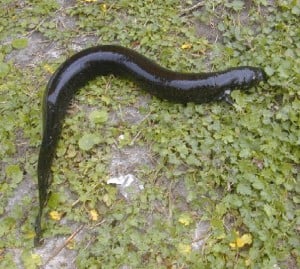Greater Siren
Virginia south to Florida and east to Alabama.
Natural Habitat:
The greater siren is aquatic, and found in streams, swamps, lakes and rivers. It is also nocturnal, spending days buried in mud and nights hunting for food.
Captive Housing:
Sirens get large and can be active pets. The best way to house an adult is in a 100-gallon aquarium. They burrow in mud in the wild, but this makes for a very messy tank in captivity. I recommend a substrate comprised of large aquarium gravel. Add to this all sorts of hides, including sunken tubes, ceramic planters, mopani wood and similar items. Plastic plants can be added to provide additional security.
Water quality is important; use a good filter to keep the water clear. An average temperature of about 75 degrees Fahrenheit works fine; a bit higher or lower won’t hurt. Lighting is optional, though for best viewing I recommend a fluorescent UV tube across the top of the tank. A secure top is a must, as sirens are known to leave their tanks at night if given the chance. For new acquisitions I recommend attaching a towel or pillowcase beneath the enclosure’s screen top, because when first acquired sirens will sometimes rub their noses on the screening while seeking a way to escape at night.
Diet:
Sirens are carnivorous for the most part, although there are reports of plants being eaten occasionally. They will relish night crawlers, small fish, crayfish, insects and even pinky mice. No dietary supplementation is needed.
What’s Available:
Most sirens are field collected, as there is little to no captive breeding going on at this time. They are not as easy to find as they used to be, although they are more than likely common throughout their range. No morphs have been found of which I’m aware.
Extra Info:
Sirens have large gills and tiny front legs, which appear to be useless. When handled, they are known to yelp loudly.
Sirens aestivate (become dormant) during periods of drought. They will bury themselves in mud and form a slimy-on-the-inside cocoon that will enable them to survive until the drought is over. Reportedly, in lab experiments, sirens have remained in these cocoons for almost five years and survived!
The greater siren is one of the coolest animals I’ve ever kept. It attains an impressive size and reminds me of an aquatic summer sausage. Of course it does not take to handling, and picking a siren up by hand should be avoided. If you must move one, use a large fish net. Greater sirens are neat animals, hardy and easy to keep.

